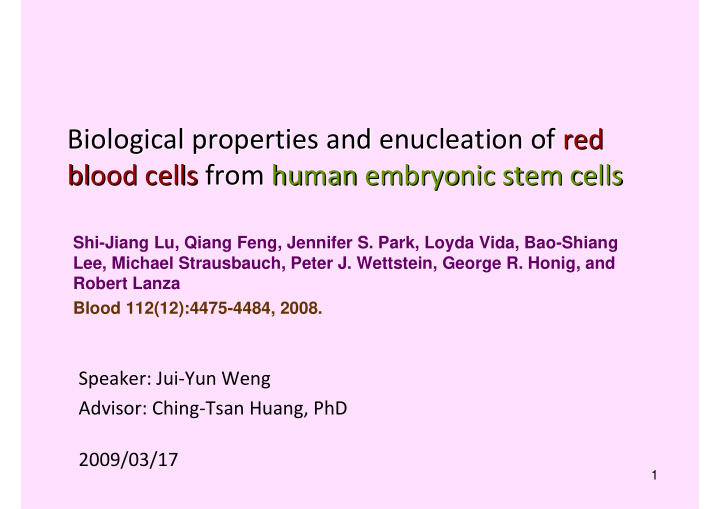



Biological properties and enucleation enucleation of of red red Biological properties and blood cells from from human embryonic stem cells human embryonic stem cells blood cells Shi-Jiang Lu, Qiang Feng, Jennifer S. Park, Loyda Vida, Bao-Shiang Lee, Michael Strausbauch, Peter J. Wettstein, George R. Honig, and Robert Lanza Blood 112(12):4475-4484, 2008. Speaker: Jui ‐ Yun Weng Advisor: Ching ‐ Tsan Huang, PhD 2009/03/17 1
Blood transfusion • Blood donation • Surgery , serious accident, Sickle Cell Anemia • RhD( ‐ ) blood type (western:~15% ; Asia: <0.3%) RhD( + ) patient A RBC B RhD ? RhD( ‐ ) patient RBC B A • Pathogen (HIV, hepatitis B virus … ) 2
HIV 0.1~0.5% 15~20% 3
Using stem cells to generate red blood cells • Less rejection response • Enucleated cells ‐‐ problem of using stem cells Carcinogenesis!! Carcinogenesis!! 4
Using stem cells to generate red blood cells Hemangioblast Stem cell hematopoiesis Red blood cell • Scale up the production: reproducible sources • Universal red blood cells ‐‐ O/RhD RhD( ( ‐ ‐ ) ) O/ • Pathogen ‐ free 5
framework ABO?RhD? Human embryonic stem cells (hESCs) hemagioblasts hemagioblasts Characterization + stromal stromal cell cell + Day 19-21 + IL3 + IL3 Hemoglobin Erythroid cells FACS analysis Erythroid cell Functional analysis Day 36-42 Day 28 Enucleation Further Maturation O 2 equilibrium curves Mature/immature marker Morphology 6
Culturing hESCs WA01 MA01 MA99 HuES-3 Embryoid body formation Day -3.5~0 & Hemangioblast precursor induction Day 0~10 Hemangioblast expansion Erythroid cell differentiation and expansion Day 11~20 Day 21 Enrich of erythroid cells 7
Culturing hESCs • 10 10 ‐ 10 11 cell/6 ‐ well plate of hESCs • 12 ‐ 16 μ m in diameter (day 21) From 2x10 6 hESCs 1000x 8
Hemoglobin of erythroid cells Electrospray ionization mass spectra Adult hemoglobin: 2 α +2 β Fetal hemoglobin: 2 α +2 γ Embryo: α , γ , ζ , ε No β -globin Early developmental stage 9
FACS analysis (fluorescence activated cell sorter) Cells labeled with antibody % % (Fetal Hb) 10 10 Immature cell marker
11 11 O 2 equilibrium curves Functional analysis
Enucleation Hemangioblast (day 7) + IL3 + stromal cell co-cultured OP9 co-cultured Normal RBCs Day 42 1000x 1000x Condition Enucleation % w/o co ‐ cultured 10 ‐ 30 Human mesenchymal stem cell 30 OP9 mouse stromal cell 30 ‐ ‐ 65 65 30 12 12
13 13 Further maturation Immunofluorescence staining Further maturation Immature Mature
Further maturation Immunofluorescence staining Further maturation 14 14 DAPI: dye for nucleotide
Enucleation and maturation Enucleated Hemangioblast ( 6-8 μ m) N/C =nuclear to cytoplasm ratio normal RBC: ~7 μ m 15 15
Further maturation Benzidine + Wright-Giemsa stain 16 16
ABO and RhD Genotyping RhD --PCR for the intron 4 of RhD sequence RhD(-) 17 17
ABO and RhD Genotyping ABO --PCR+RE based on polymorphism of glycosyltransferase B A O B A A B MA99 B ‐ MA133 A ‐ WA01 O+ WA07 B+ WA09 A+ MA01 A+ MA09 B+ 18 18 (O, O)= O type (B, O)= A type (B, B)= B type
O/RhD RhD( (- -) ? ) ? O/ hESCs 19-21 days Protein mass Protein mass Fetal/embryo OP9 stromal cell hemoglobin Enucleation Enucleation FACS FACS Fetal Hb:65% 30~65% CD71:76% Erythroid cells O 2 equilibrium curve O 2 equilibrium curve Further maturation Further maturation Normal ability ↓ , ↑ CD71 ↓ , CD253a ↑ β -hemoglobin ↑ ↑ 19 To be continued… … To be continued
Thank you for your attention! 20 20
Recommend
More recommend